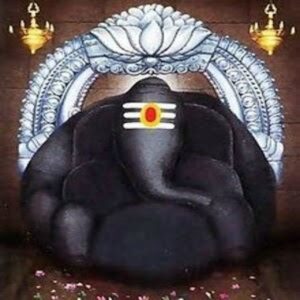
Kanipakam is a village on the bank of Bahuda River in Irala mandal, located in Chittoor district of the Indian state of Andhra Pradesh. It is home to a popular Hindu temple of Lord Ganesha called as Kanipakam Vinayaka Temple.
The idol of ‘Swayambhu’ Vinayaka is inside ‘Kalyani’, a lake in which the idol was originally found. ‘Swayambhu’ means that the idol was not carved out of stone to be reinstated at a temple, but was found as it is.
The temple has Chola architecture, with a simple yet elegant Gopuram for the temple complex that houses temples of two other deities – Sri Manikanteshwara and Sri Varadaraja Swamy.
The word ‘Kanipakam’ originates from two Tamil words – ‘Kani’ meaning ‘wetland’ and ‘Pakam’ meaning ‘flow of water’. According to the legend behind Sri Vara Siddhi Vinayaka Temple, there were three brothers, each suffering with one deformity; one was dumb, another deaf and third one was blind. In spite of the difficulties, they worked on a small piece of land, cultivating it so as to earn their livings. However, one day they when they were trying to get water from well using the Piccota system, they found out that the well had dried up. Hence, one of the brothers started digging the well further. During that process, an iron hit a stone formation. This filled the well with blood. Brothers were shocked with the sight of blood in the well, as they witnessed the sight; their physical disabilities got automatically cured. When the villagers came to know about the miracle, they tried to further deepen the well. In spite of constant trying they couldn’t do it as by then Lord Vinayaka’s idol had self manifested itself, emerging out of the water of the well.
The villagers offered prayers to Lord Vinayaka by performing Aarthi to the newly found idol and offering tender coconuts, as Lord Ganesha is fond of them. The tender coconut water flowed into a channel to a distance of more than one and a quarter acres. Thus originated the name of ‘Kanipakaram’ – which evolved to get modified as ‘Kanipakam’
It is also believed that the Lord Vinayaka idol at Kanipakam has been growing in size on a daily basis. At present devotees can see up to the abdomen and knees of the Lord Vinayaka. Hence, it is seen that the Lord’s idol has outgrown the armour or kavacham which was offered about 50 years ago by Smt. Lakshmamma.
Even today the idol is in the original well and the springs of the well are perennial and the eternal. During the rainy season, the holy water from the well overflows even today.
The legend behind Bahuda River
Long ago there lived two brothers Sankha and Likhita. They were on a pilgrimage to Kanipakam. As the journey was tiring, the younger brother Likhita felt hungry. Disregarding the advice of the elder brother he plucked a mango from the mango grove. Sankha felt bad and reported this to the ruler of that area and pleaded for punishment for the sin committed during the pilgrimage. Thus Likhita was punished severely being deprived of both arms.
Later they took bath in the river near Kanipakam temple. Lo Behold! The chopped arms were restored to Likhita as soon as he had a dip in the sacred waters of the river. These incidents lead the ruler to rename the river as ‘Bahuda’ (Bahu means human arm). Thus the river beside Kanipakam temple is now known as ‘Bahuda River’.
Sri Varasiddhi Vinayaka as up-holder of ‘Truth’
This sacred shrine is widely believed to be an upholder of truth and justice. The aura of the Divine Almighty is such that, there are several occasions in which a person accused of a sin voluntarily admits to wrong-doing and sinful acts when he enters the temple premises or takes a dip in the holy water. It is as if the Lord evokes a sense of fearful guilty conscience in the mind of the person and makes him genuinely repent for the same.
Even the pragmatic Western minds of British folks surrendered to the Lord at this sacred altar – During the pre-independence era, the British jury at the Chittoor court used to acquit an accused person if he were to swear at the holy shrine proclaiming his innocence in the issue!
To this day, everyday quarrels between villagers are resolved by the two people involved taking a ‘Pramanam’ – a special oath in which they take a dip in the Pushkarini and testify before the Lord, is believed to be the gospel truth! It is believed that the Almighty casts His divine spell on the parties involved, purifies their hearts of anger, lust, jealousy and envy, thereby making the guilty pray to Him to seek forgiveness. The issues are thus resolved, without the interference of police or middlemen.
Devotees who wish to give up bad habits like smoking or excessive drinking – take a bath in the holy place and take an oath in the temple by contributing Rs. 516/-. This is a Seva called ‘Pramanam’ and hundreds of devotees have reaped the benefit of this special seva at the Kanipakam shrine.
One of the main annual attractions of the place is ‘Brahmostavam’ held for duration of twenty-one days. It starts from the day of Ganesh Chaturthi and continues for twenty days with festive pomp and vigour.
Source:
https://www.myoksha.com/kanipakam-temple/#
http://tirupatitourism.in/kanipakam-sri-varasiddhi-vinayaka-temple
https://en.wikipedia.org/wiki/Kanipakam
http://www.kanipakam.com/maintemple.html


